
INSTALLATION, OPERATION & MAINTENANCE INSTRUCTIONS
CAUTION: Only qualified personnel should undertake the procedures outlined in this document.
NIBCO INC., its agents, representatives and employees assumes no liability for the use of these
procedures. These procedures are offered as suggestions only.
NIBCO Technical Services • Phone: 1.888.446.4224 • Fax: 1.888.336.4224
1
Review Date: 01/18/2012
Original Date: NA
Installation and Maintenance Guidelines for
NIBCO
®
Cast Iron, Alloy Iron and Ductile Iron Gate Valves
2” to 24” Class 125, 150, 175 and 250
Figure Numbers
F-617-0
F-617-13
F-617-ON
F-637-31
F-637-33
F-667-0
F-619
F-619-N
F-639-31
F-639-33
F-607-OTS
F-609

NIBCO Technical Services • Phone: 1.888.446.4224 • Fax: 1.888.336.4224
2
1.0 GENERAL INFORMATION
1.1 SCOPE
These instructions are furnished for use in the installation, operation and maintenance of
NIBCO 2” to 24” Class 125, 150, 175 and 250 bolted bonnet solid wedge gate valves
having handwheel operation.
1.2 GENERAL DATA
A. MANUFACTURER
NIBCO INC.
1516 Middlebury Street
Elkhart, IN 46516
Phone: (574) 295-3000
B. FIGURE NUMBERS AND DESCRIPTIONS
Cast Iron:
F-617-0 Class 125, flanged end, rising stem, I.B.B.M., O.S.&Y.
F-617-ON Class 125, flanged end, rising stem, all iron, O.S.&Y.
F-619-0 Class 125, flanged end, non-rising stem, I.B.B.M.
F-619-N Class 125, flanged end, non-rising stem, all iron
F-667-0 Class 250, flanged end, rising stem, I.B.B.M., O.S.&Y.
F-669-0 Class 250, flanged end, non-rising stem, I.B.B.M., O.S.&Y.
F-607-OTS WWP 175, flanged end, rising stem, I.B.B.M., O.S.&Y.
F-609 WWP 175, flanged end, non-rising stem, I.B.B.M.
Alloy Iron:
F-617-13 Class 125, flanged end, rising stem, 3% nickel, stainless trim,
O.S.&Y.
Ductile Iron:
F-637-31 Class 150, flanged end, rising stem, D.I.B.B.M., O.S.&Y.
F-637-33 Class 150, flanged end, rising stem, stainless trim, O.S.&Y.
F-639-31 Class 150, flanged end, non-rising stem, D.I.B.B.M.
F-639-33 Class 150, flanged end, non-rising stem, stainless trim
ANSI B16.5 150 Class flanges will match up with
ANSI B16.1 125 Class iron flanges
ANSI B16.5 300 Class flanges will match up with
ANSI B16.1 250 Class iron flanges
C. IDENTIFICATION PLATES
An aluminum identification plate is attached beneath the handwheel nut. This
identification plate gives the figure number of the valve, some general information
about the trim and location of NIBCO’s corporate offices.

NIBCO Technical Services • Phone: 1.888.446.4224 • Fax: 1.888.336.4224
3
When more detailed information is required, the NIBCO catalog should be
referred to using the valve figure number as the guide.
D. SERVICE
When installing valves for service in corrosive media, the NIBCO Chemical
Resistance Guide may be consulted for specific data or contact can be made
with NIBCO Technical Services. It is, however, the obligation of the user to make
the ultimate decision of fitness for use.
E. PRESSURE TEMPERATURE RATINGS
Pressure and temperature ratings may be found in the Engineering section of the
latest printing of NIBCO catalog for the specific product needed. This information
is taken from applicable ANSI Standards.
F. CODES & REGULATIONS
A valve specified for use in compliance with the ASME Boiler and Pressure
Vessel Code, the ANSI Pressure Piping Code, government or other regulations,
is subject to any limitation of that code or regulation and to other related
applicable ANSI Standards.
G. PRODUCTION TEST PROCEDURES
Valves are pneumatically shell and seat tested at a pressure of 80 psi in
accordance with Federal Specifications and MSS SP-70 Manufacturers
Standardization Society requirements.
I. F-637 and F-639 Ductile valves – Have a Hydrostatic shell test of
440 PSI.
II. F-637 and F-639 Ductile valves – Pneumatic seat test each seat
of 80 PSI. Allowable leakage per MSS SP-70.
F-637 – Hydrostatic seat test equal to maximum service pressure
for which the valve is rated. Allowable leakage per MSS SP-70.
III. All other valves are tested in accordance with MSS SP-70.
H. PRINCIPAL DIMENSIONS
Principal dimensions of the valve are specified in the appropriate catalog 5-100.
1.3 DETAILED DESCRIPTION
The gate valves listed above and covered in these guidelines are ductile iron, cast iron,
alloy iron, bolted bonnet, outside screw and yoke - rising stem and inside screw - non
rising stem valve types. The valve is operated with the handwheel. They are used to
start or stop the flow of fluids in piping system. Clockwise rotation of the handwheel
closes the valve. These valves should be used in the full on or full off position only.

NIBCO Technical Services • Phone: 1.888.446.4224 • Fax: 1.888.336.4224
4
The body and bonnet are bolted together with bolts and nuts; and the joint is sealed with
a non-asbestos gasket. Flow through the valve is stopped by forcing the wedge down
between the seat rings which are screwed into the body. The wedge is the solid type and
is guided through its entire travel by matching guides in the body.
A. RISING STEM OS & Y GATE VALVE
In NIBCO O.S.&Y. rising stem valves, the bottom of the stem screws into the
wedge and is prevented from unscrewing by installing a solid wedge pin. In sizes
14"-24" some designs have an interlocking type stem-wedge connection without
threads or a wedge pin. For the specific valve, this is shown in the appropriate
catalog (5-100).
The wedge is raised and lowered in the waterway by rotating the handwheel
which is attached to the yoke bushing. The handwheel tits onto the hex end of
the yoke bushing and is held on by the handwheel nut which is threaded onto the
top of the yoke bushing. The inside diameter of the yoke bushing has threads
that mate to the upper stem threads. The yoke bushing is held in the top of the
bonnet by the bonnet cap against the rim on the bottom of the yoke bushing. As
the yoke bushing is rotated, the stem and wedge move up and down. The stem
in an O.S.&Y. rising stem gate valve does not turn.
The stuffing box is formed by the circular space between the stem and bonnet
and is filled with non-asbestos packing. The packing is compressed in the
stuffing box by the pack gland bushing and packing gland follower, which are
drawn down against the packing by two gland bolts and nuts. This prevents
leakage between the moveable stem and the stationary bonnet of the valve.
B. NON-RISING STEM GATE VALVE
In NIBCO non-rising stem iron valves, the stem is one piece but has an integral
shoulder on it of a larger diameter than the stem operating diameter. This
shoulder is held in a pocket, in the bonnet when the sniffing box is placed on top
and securely fastened. The stem is operated by the turning of the handwheel.
The threads on the bottom of the stem engage the threads inside the wedge
raising it up and down, when the stem is turned by the handwheel. For non-rising
stem valves, the handwheels fit onto a tapered square end of the stem. The
handwheel is held on by a nut screwed onto threads on the end of the stem.
The stuffing box is formed by the circular space between the stem and bonnet
and is filled with non-asbestos packing. The packing is compressed in the
stuffing box by the pack gland bushing and packing gland follower, which are
drawn down against the packing by two gland bolts and nuts. This prevents
leakage between the moveable stem and the stationary bonnet of the valve.
These bolts have two sets of nuts. The top set is used for adjusting the packing.
The bottom set holds the stuffing box onto the bonnet so it is important not to
loosen or tighten these nuts unless you intend to disassemble or reassemble the
stuffing box from the bonnet.

NIBCO Technical Services • Phone: 1.888.446.4224 • Fax: 1.888.336.4224
5
2.0 INSTALLATION
2.1 PRELIMINARY INFORMATION
Gate valves should preferably be installed with the stem pointed vertically upward.
However, it is normally acceptable to have the valve stem pointed in a horizontal position
either in vertical or horizontal piping. Although a gate valve will function satisfactorily in
an inverted position it is not generally recommended because it allows fluids to become
trapped in the bonnet cavity resulting in contamination and inability to fully drain the
system. This is critical in water lines exposed to freezing temperatures.
Valves are shipped in the closed position to prevent damage to the seating surfaces.
There is no internal blocking used for shipment.
2.2 HANDLING AND INSTALLATION
Each valve should be handled only with apparatus that will safely support the valve
weight. Slings should never be placed around the handwheel, stem, or gland adjustment
parts. First raise the valve to the vertical position and block it. Reposition the slings and
lift the valve vertically. Remove the expendable end protectors, if present, and install the
valve according to the piping layout.
For installation of valves into pipelines, flange bolting and gaskets, are governed by the
applicable code for pipeline specification. While the valve is being installed, it should be
kept in the closed position; and care should be taken to prevent foreign material from
entering the valve. For flange bolting data, refer to appendix.
After installation and during system testing, the gland nuts should be tightened uniformly,
if necessary, until leakage through the packing is stopped. Tighten the nuts just enough
to prevent leakage. Excessive tightening may cause difficult operation of the valve,
damage the stem, and shorten packing life.
CAUTION: Care should be taken during handling, installation, and operation to prevent
personal injury and damage to valve components, especially seating surfaces.
3.0 OPERATION
Gate valves should never be used for throttling purposes. They should be fully opened
or fully closed. If the valves were only slightly opened, wire drawing and erosion of the
wedge and seats would result. Valves should not be tightly back-seated as line
contamination over a long period of time may lock up the valve causing problems when
the valve has to be closed.
4.0 TROUBLESHOOTING
Prior to doing any work on any NIBCO valve, it will be necessary to shut down the piping
system, remove pressure and drain, and if necessary, allow cooling and/or
decontaminating before proceeding.

NIBCO Technical Services • Phone: 1.888.446.4224 • Fax: 1.888.336.4224
6
4.1 LEAKAGE THROUGH THE BONNET JOINT
1. Remove the handwheel from the stem.
2. Mark the body – bonnet flanges with a piece of chalk so they can be matched up
later.
3. Remove body-bonnet nuts and bolts.
4. Carefully remove the bonnet assembly. Be careful not to nick or scratch the wedge
seats.
5. Thoroughly clean the body and bonnet joint surfaces.
6. Check the body and bonnet gasket surfaces for any scratches or gouges or other
irregularities.
7. In the event the surfaces are marred, they must be filed or machine flat again. If the
damage is considerable, the body or bonnet may have to be replaced. A competent
valve shop or machine shop may have to be consulted or contact NIBCO Technical
Services or your nearest NIBCO representative for help.
In many cases it is less costly to replace the entire valve rather than have it repaired.
8. With the surfaces now clean and flat again place the gasket on the body and replace
the bonnet. Be careful to use the chalk marks to put everything back together the
same way it came apart. Always use a new clean fresh gasket. It does not pay to
take a chance using the old gasket over again.
9. Reinstall the body-bonnet nuts and bolts, and then carefully check to see that the
body and bonnet are in the same position as when they were separated. Follow the
bolt torquing procedure in Appendix I.
10. Pressure test the valve for leakage to see if a good joint has been made.
4.2 LEAKAGE THROUGH THE VALVE SEAT
Leakage across the valve seat most of the time is generally due to foreign matter lodged
in the seat. Occasionally, such foreign material can be washed away by allowing flow
through the valve. In valves that are used with fluids that are contaminated and known to
cause buildup a drain can be installed at the bottom of valve so the seats can then be
flushed prior to closing. At times the leakage may be overcome by tightening the valve
further. If the leakage persists, disassemble the valve and examine the seat surface on
the wedge and the seat surfaces within the body. (See section 4.1)
Minor scratches can be corrected by polishing the wedge face, but generally if there are
deep scratches in the body seats, the valve should be removed from the line and
replaced or repaired by a competent valve shop. If the wedge does have scratches it is
generally acceptable to take a piece of 400 grit sandpaper, lie it upon a flat plate, such
as an inspectors table (granite slab) (glass of modern manufacture is remarkably flat and
true) and slightly polish the surface of the wedge. This will remove some of the scratches

NIBCO Technical Services • Phone: 1.888.446.4224 • Fax: 1.888.336.4224
7
and possibly reduce the amount of leakage. Critical to good valve performance is to
keep the surfaces flat and not to change the angle of the wedge or body seats.
4.3 LEAKAGE THROUGH THE STUFFING BOX
Leakage through the stuffing box packing may be stopped by tightening the packing
nuts. Excessive tightening may cause difficult operation of the valve and could cause
damage to the stem or packing nut. Do not over tighten. The adjustment should be just
tight enough to stop the leak.
If the pack gland follower has run out of travel, isolate and depressurize the valve for
repacking or the addition of more packing.
Repacking of valves under pressure is not a recommended practice. This is dangerous
and could result in serious injury even if the valve appears to be back-seated. Foreign
matter may have accumulated on the back seat, or by accident the stem could be
knocked off the back seat position, thereby allowing maintenance personnel to be
exposed to potentially dangerous fluids, imder pressure which could result in serious
injury. Prior to proceeding to change packing, it will be necessary to shut down the
piping system, remove pressure and drain, and if necessary, allow to cool and/or
decontaminate before working on the valve.
For non-rising stem valves (F-619, F-619-N, F-639-31, F-639-33), remove the
handwheel nut, I.D. plate, handwheel, the top two nuts (packing nuts), pack gland
follower, and pack gland to remove or add to packing. Remove the packing being careful
not to scratch the stem or the inside of the packing well.
For rising stem valves (F-617-0, F-617-ON, F-637-31, F-637-33, F-617-13, F-667-0), it is
not necessary to remove the handwheel. Remove the packing nuts and bolts, slide the
pack gland follower, pack gland up out of the way and keep out of the way with tape or
some other convenient temporary method.
If the packing is removed, discard and do not try to put it back once it has been
removed. Reusing old packing is a gamble not worth taking. Clean the stem and
examine it for damage. Install the new packing, which may either be rope packing or cut
rings. Rope packing is sometimes spiral wound around the stem and pushed into the
stuffing box. If rope is used, make sure there is enough put into the packing chamber so
a little bit will stick up over the top. When the packing is compressed by the gland it
should then be slightly lower than the top, If rings are used, install one ring at a time with
the diagonal cut in each ring being staggered 90° away from the cut in the ring below.
Each ring should be firmly compressed in the stuffing box after it is placed in position
before the next ring is added. Install the packing gland and pack gland follower, packing
nuts, and tighten down. The packing nut should be tightened only enough to prevent
leakage. Pressurize the valve and check the packing for leakage. Retighten as required.

NIBCO Technical Services • Phone: 1.888.446.4224 • Fax: 1.888.336.4224
8
5.0 MAINTENANCE
5.1 TOOLS AND EQUIPMENT
Standard wrenches and tools are suitable for servicing valves as follows:
A. For removing bonnet-body nuts and bolts a full set of 1/2” and 3/4” drive sockets is
normally used. Pipe wrenches used on nuts or bolts have a definite crushing action
which will deform them and is not recommended.
B. A standard packing tool can be used and/or a blunt hook is sometimes used to
remove packing rings. A screwdriver to raise the packing gland (if it is in the fully
down position) and generally combination box – open end wrenches are used to
tighten the packing nuts.
C. Combination oil stone and flat plate glass course with fine 400 grit sandpaper to
polish the wedge. Flat plates to check high spots on flat surfaces such as bonnet,
seal surface and wedge in conjunction with machinist blueing.
D. Punches, hammer, pliers, files, wire brush, putty knife, chalk and other tools
generally contained in a good set of mechanics tools will be needed for things like
cleaning up the gasket surfaces, removing pins from stem-wedge connections, etc.
6.0 SPARE PARTS
Normal spare parts to be maintained on hand are listed on the NIBCO spare parts list.
If the bonnet or body is damaged, it is normally less expensive to remove the entire
valve from the line and install a new one.
When placing an order for spare parts, it is necessary to give the size, the valve figure
number found on the aluminum identification plate and also heat numbers, part
numbers, and date code numbers which are generally cast into the valve body on its
side. Designs have had modifications over the years which could render the parts
useless if they are of a different configuration, so proper identification is very important.
7.0 MAJOR REPAIRS
For other repairs or replacements not covered in the above description, contact the
Technical Services Department of NIBCO INC. for special instructions. Always give the
figure number and size shown on the identification plate affixed to the valve.

NIBCO Technical Services • Phone: 1.888.446.4224 • Fax: 1.888.336.4224
9
APPENDIX I
Body to Bonnet Bolt Installation Procedure for
NIBCO Cast Iron, Alloy Iron and Ductile Iron Valves
The following procedure outlines the methods to be used in the assembly of and field installation
of the body to bonnet bolts and nuts in order to assure the proper clamping stresses. The
correct sequence and torque for tightening the body to bonnet bolts and nuts is also identified.
These instructions apply for ASTM A307 Grade B high tensile strength bolting material used on
NIBCO cast iron, alloy iron, and ductile iron valve body and bonnet flange joints.
1. Visually inspect all threads and remove all foreign matter such as rust, dirt, corrosion
and any lubricant.
2. Clean the body gasket and bonnet gasket seating area thoroughly.
The gasket seating area must be clean prior to assembly as the area becomes
inaccessible after assembly. The area is to be cleaned with a suitable solvent or
cleanser that can remove all dirt, grime and gasket particles.
3. The threads of the bolts and the surfaces under the bolt heads and nuts to be coated
with an anti-seize compound such as Felpro, type C5A Hi-Temp Anti-seize compound or
equal. The threads of the nuts should also be lubricated. Clean off excess lubricant with
solvent as noted in Item 2.
NOTE: Resilient-Wedge Gate Valves use only socket head cap screws to attach bonnet
to body, no nuts.
4. Clean off the gasket. Make sure that no foreign particles are stuck to it that might cause
a leak. Make sure the gasket is the correct size. It should fit inside the bonnet-body bolt
holes.
5. Place the bonnet in position; insert the bolts and hand tighten the nuts against the body.
A minimum of 2-1/2 threads should extend beyond each nut.
6. After the nuts are hand tight, follow the tightening sequence shown in the table. The
sequence shown is an illustrated method only, and the actual sequence is dependent
upon the total number of bolts.
7. The use of an air impact device which does not have a direct torque control is prohibited
for the torquing of body to bonnet bolts. The use of a hand torque wrench, electronic
torquing system, or power wrench with direct torque control is recommended. If such
equipment is not available, the following standard wrenches may be used:
1/2” bolts 6” wrench
5/8” bolts 12” wrench
3/4” bolts 18” wrench
7/8” bolts 24” wrench
1” bolts 36” wrench

NIBCO Technical Services • Phone: 1.888.446.4224 • Fax: 1.888.336.4224
10
IRON VALVE BOLT TORQUE
Before tightening, make sure all surfaces that the fastener will contact are clean and dry.
The torque tightening table listed below applies to clean, undamaged, non-lubricated threaded
fasteners (lubricated threaded fasteners may require less torque – consult the fastener
manufacturer for more detailed instructions).
When tightening, use the sequence chart below. Tighten in two steps.
1. Tighten fastener using about 1/2 the final torque figure.
2. Final tightening using the full torque figure. ASTM A307 steel only.
Fastener Size
7/16
1/2
9/16
5/8
3/4
7/8
1
1-1/8
1-1/4
1-3/8
1-1/2
Torque in Ft. Lbs.
30
45
66
93
150
202
300
474
659
884
1057
BOLT TIGHTENING SEQUENCE
For any technical enquiries please call NIBCO Technical Services.
-
 1
1
-
 2
2
-
 3
3
-
 4
4
-
 5
5
-
 6
6
-
 7
7
-
 8
8
-
 9
9
-
 10
10
Ask a question and I''ll find the answer in the document
Finding information in a document is now easier with AI
Related papers
-
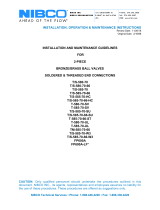 Webstone, a brand of NIBCO CT58580LFHD34 Installation guide
Webstone, a brand of NIBCO CT58580LFHD34 Installation guide
-
NIBCO NLG200K Installation guide
-
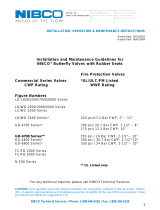 NIBCO NLH801H Installation guide
NIBCO NLH801H Installation guide
-
NIBCO Bench Press GYM Fitting Operating instructions
-
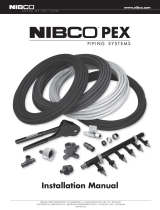 NIBCO PX40251 Installation guide
NIBCO PX40251 Installation guide
-
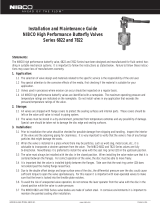 NIBCO NLL203H Installation guide
NIBCO NLL203H Installation guide
-
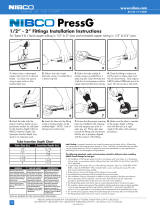 NIBCO PressG Installation guide
NIBCO PressG Installation guide
-
NIBCO NPC280 User manual
-
NIBCO PressACR User manual
-
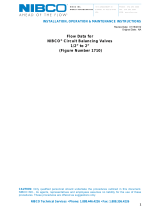 NIBCO Circuit Balancing Valve Installation guide
NIBCO Circuit Balancing Valve Installation guide
Other documents
-
William Powell Co 0.75 GA08SA58GB Installation guide
-
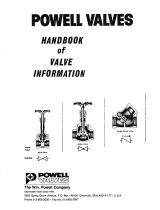 William Powell Co 2.0 2341SN0TXXX Installation guide
William Powell Co 2.0 2341SN0TXXX Installation guide
-
Apollo 7040201 Installation guide
-
Apollo Conbraco 7064456 Installation guide
-
DANCO 124140 Installation guide
-
DANCO 124144 Installation guide
-
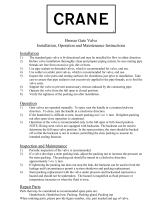 Crane Valve/Crane Energy Flow Sol 431UB*004 Installation guide
Crane Valve/Crane Energy Flow Sol 431UB*004 Installation guide
-
Apollo Conbraco 82LF24501 Installation guide
-
 Powell Valves Pressure Seal User manual
Powell Valves Pressure Seal User manual
-
Apollo Conbraco 60B10324 Installation guide


















